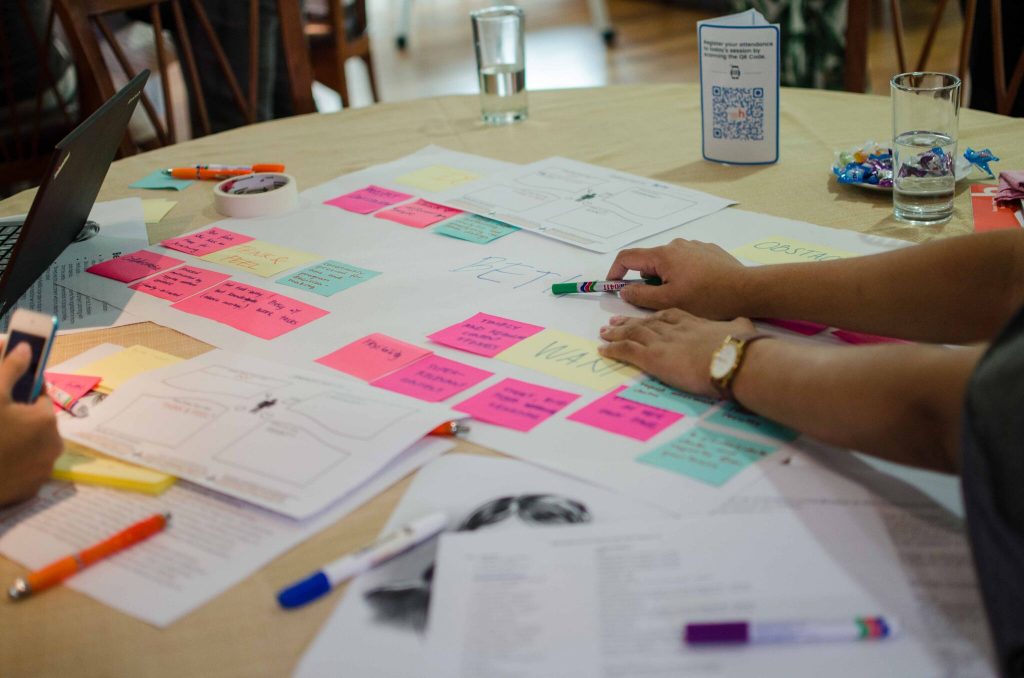Brainwriting

Silently build collective ideas
Overview
Brainwriting is a non-verbal idea-generating methodology. Like brainstorming, brainwriting allows a group to collectively build an idea. Brainwriting is a technique to overcome the tendency for judgment, personality clashes and the fact that one participant can express him/herself at any given time.
How to use it
- Produce ideas and stimulate creativity
- Define ideas
- Overcome blocks and think critically
- Plan approaches or solve problems
- Make sure reserved/introspective group members are heard
How to apply it
Start:
- Present the subject (e.g. a problem, project, outcome, organization or idea) to the group as a challenge.
Setting:
- 6-8 participants in a group around a table or in a circle facing each other.
- Everyone has an equal opportunity to contribute.
Materials:
- One paper/card and pencil for each participant.
Time/Steps:
- Clearly establish the three critical rules:
- There are no bad ideas. Now is the best time to think outside the box.
- No judgements will be accepted, because this is the stage for free flowing of ideas.
- This exercise is intentionally silent and has to stay that way.
- Write the topic around which you need to generate ideas on whiteboard. Make sure that the whiteboard is visible for all the participants.
- Distribute the cards and the pencils to the participants.
- 3 – 5 minutes: Ask the participants to generate ideas concerning the topic and make sure they write them on their cards.
- 25 – 30 minutes (or until the participants exhausted their creativity): When the participants are finished with writing down their ideas, ask them to pass their card to the person on their left. Tell the participants to read the card they received and ask them to add ideas to the card. The ideas already present on the card must be considered as “idea stimulation” impulses. After adding ideas to the card, ask the participants again to pass the card to the person on their left. Continue this process of passing cards until each participant is again in possession of his/her original card.
- Collect the cards and stick them on the whiteboard around the topic.
- Let the participants come to the whiteboard and ask them to put stars/dots next to the ideas they find the most decisive.
How to adapt it
- Verbal adaptation: brainstorming
Case study
Title:
Promoting reflection
Activity:
Strengthening Labour Inspection workshop
Contact:
B.Sorensen@itcilo.org (Social Dialogue)
Description:
The participants were asked to sit in groups of eight persons. The objective of the activity was to identify indicators for measuring the effectiveness of the labour inspection. The first participant of the group of eight was given a paper and pencil. He/she had to write a first indicator and pass the paper on to his/her neighbour. The other group members had to come up with an additional indicator. This methodology was deemed effective for making sure participants think about possible different indicators for their institutions since they have to reflect and propose new indicators. It is also effective to make sure that the most introverted person also has a chance to collaborate to the process of collectively identifying indicators.
Resources
- http://www.kstoolkit.org/Brain+Writing
- Gray, D., Brown, S., & Macanufo, J. (2010). Gamestorming: A playbook for innovators, rulebreakers and changemakers. California, CA: O’Reilly Media, Inc.





